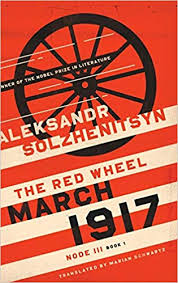Gary Saul Morson at The American Scholar:
 Aleksandr Solzhenitsyn’s multivolume historical novel about the Russian Revolution, The Red Wheel, is divided into four “nodes,” each a lengthy account of a short span of time. March 1917, the third node, is in turn divided into four volumes, the second of which is the book under review, translated into English for the first time. Combining nonfictional historical argument with novelistic accounts of the principal historical actors and a few fictional characters, March 1917 covers a mere three days of unrest and revolution, March 13–15, 1917, at the end of which Tsar Nicholas II abdicates, ending the Romanov dynasty in Russia. Marian Schwartz’s splendid translation captures the prose’s powerful pace and conveys, as few translators could, the author’s subtle use of tone.
Aleksandr Solzhenitsyn’s multivolume historical novel about the Russian Revolution, The Red Wheel, is divided into four “nodes,” each a lengthy account of a short span of time. March 1917, the third node, is in turn divided into four volumes, the second of which is the book under review, translated into English for the first time. Combining nonfictional historical argument with novelistic accounts of the principal historical actors and a few fictional characters, March 1917 covers a mere three days of unrest and revolution, March 13–15, 1917, at the end of which Tsar Nicholas II abdicates, ending the Romanov dynasty in Russia. Marian Schwartz’s splendid translation captures the prose’s powerful pace and conveys, as few translators could, the author’s subtle use of tone.
Heavily indebted to Tolstoy’s War and Peace, Solzhenitsyn (1918–2008) borrows a central insight of his great predecessor: war is far more chaotic, random, and contingent than its representation in historical narratives. Tolstoy described battle as no one had ever done before, showing soldiers moving blindly in fog with no idea what is going on and generals, unable to keep up with ever-changing situations, issuing orders that are impossible to execute.
more here.
